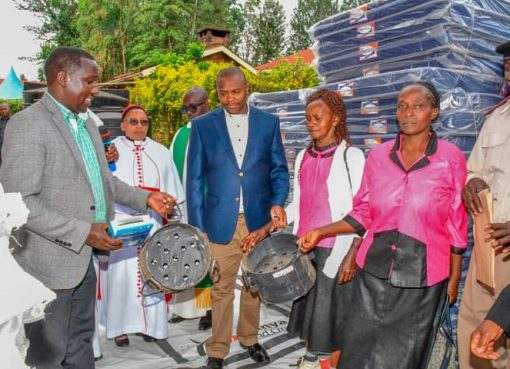Having experience after tackling the first wave of desert locusts invasion in the country, the government has assured Kenyans that it is adequately prepared to handle the second wave of desert locusts invasion and there should be no cause for alarm.
Agriculture Cabinet Secretary (CS) Peter Munya said that they have a well-coordinated approach with the counties and locals at the heart of the operation being led by county governments and the County Commissioners (CC’s).
“Where there is damage we shall work with the communities to restore their livelihoods because we live in a region that has challenges and irrespective of what we do in the country we are not in control of what happens in other countries like Ethiopia, Somalia and Yemen and even when we cleared the locusts that invaded us we were not able to do much across the borders and that is why we have the second invasion,” said Munya.
Speaking at Kilimo house on Thursday while giving a status update on the efforts that the government is taking to tackle the second wave of locusts’ invasion, Munya said that it had been predicted that the same will occur and thus the government was adequately prepared for it.
The CS highlighted that the second wave of desert locust invasion entered from Ethiopia and Somalia in mid-November 2020.
“To date, 15 Counties have reported locusts’ presence, namely: Marsabit, Wajir, Garissa, Tana River, Lamu, Kilifi, Taita Taveta, Mandera, Machakos, Kitui, Isiolo, Samburu, Laikipia, Meru and Tharaka Nithi,” explained the CS.
He said that the total number of swarms that settled in the country between November 2020 and January 2021 are 75; out of which 66 have been treated reflecting a total area of 19,100 hectares with an 80 percent success rate.
“As I indicated in Naivasha last year, the government preparedness on desert locust management has been greatly enhanced and it has established eight control bases strategically in Isiolo, Marsabit, Masinga, Garissa, Turkana (Lodwar), Mandera, Lamu (Witu), Wajir and Taita Taveta to coordinate management operations,” said Munya.
The CS added that they have deployed nine surveillance and spray aircrafts and three are on standby because the invasion has not reached the levels to deploy the extra three aircrafts but if need be they will be deployed with immediate effect.
“The invasion is very unpredictable since you don’t know when we will have extra swarms from either Ethiopia or Somalia and in fact the information we have is that there are many swarms along the border into Ethiopia that are static because the winds are not blowing due to the mountains there and they could cross anytime and that is why we have to be prepared in case the strength of the wind pushes the locusts into Kenya,” highlighted Munya.
The CS added that they have deployed 21 vehicles mounted with sprayers for ground control operations in the various bases.
“We have enough pesticides to last an additional three months and we have plans to procure more for contingency measures and to cater for the demand which is quite high since we are sending 20, 000 liters every week to the bases,” explained Munya.
Munya said that working with partners like the Food and Agriculture Organization (FAO), the Government has trained over 500 National Youth Service (NYS) personnel who have been deployed in all the field bases in the country adding that 500 more NYS personnel will be trained and deployed in the next two months.
“We have decided to train more since we have been informed that a majority of the ones we trained are graduating and we need other cadres to support us in this work,” he said.
Munya said that they have been having a coordinated approach working with stakeholders like FAO, World Bank, Kenya Defence Forces (KDF), the Desert Locust Control Organization for Eastern Africa (DLCO-EA), NYS among others with reports indicating that the situation might change for the better in a month’s time.
“The KDF has been helping us in spraying especially in areas where there is potential insecurity like Mandera, Wajir and some parts of Garissa,” said the CS.
By Joseph Ng’ang’a





